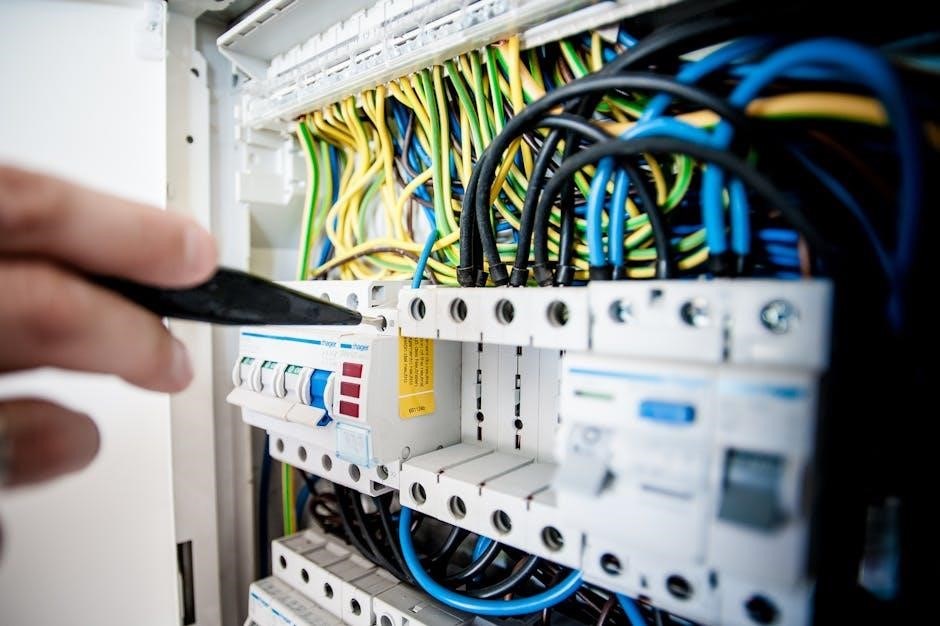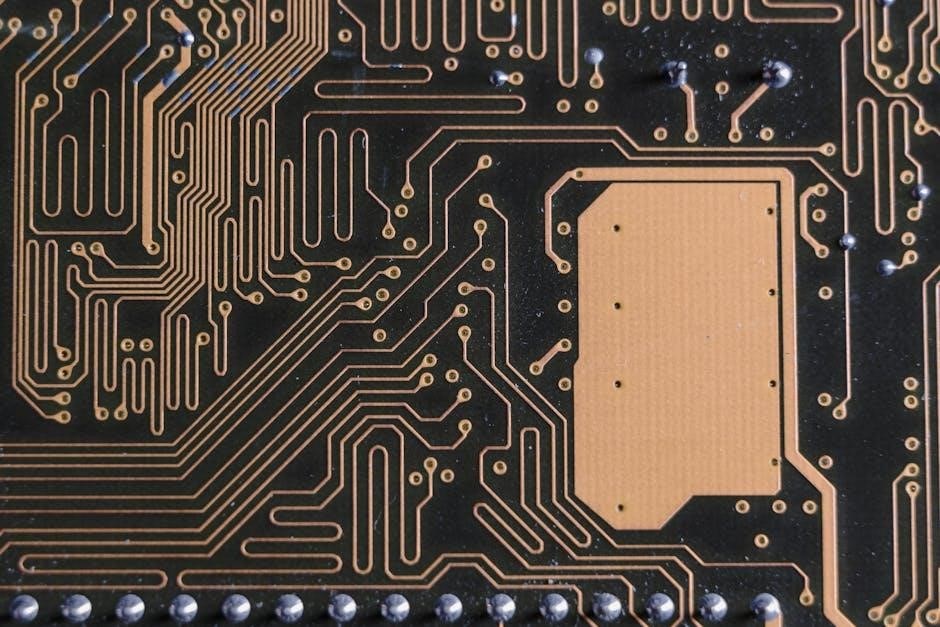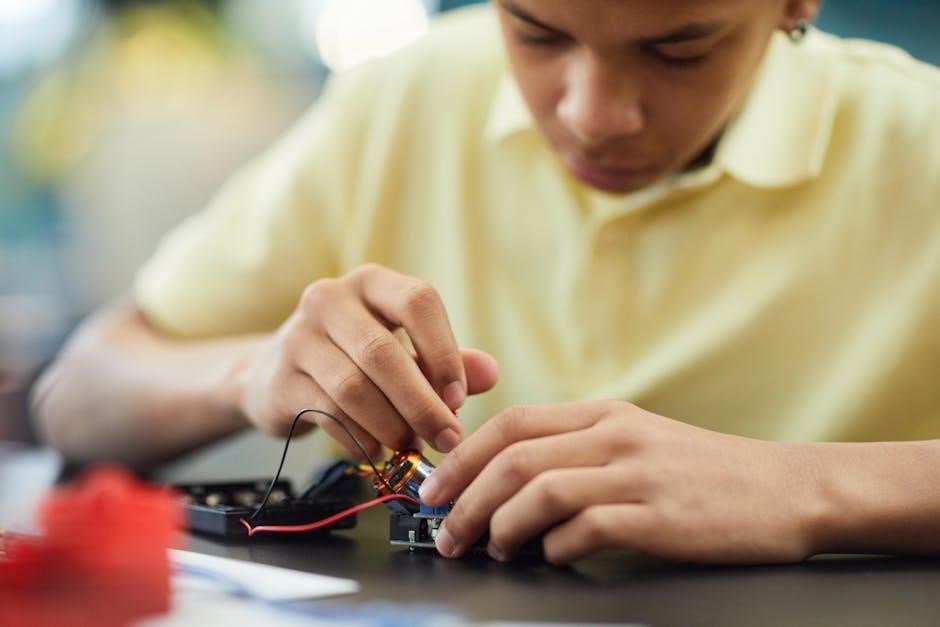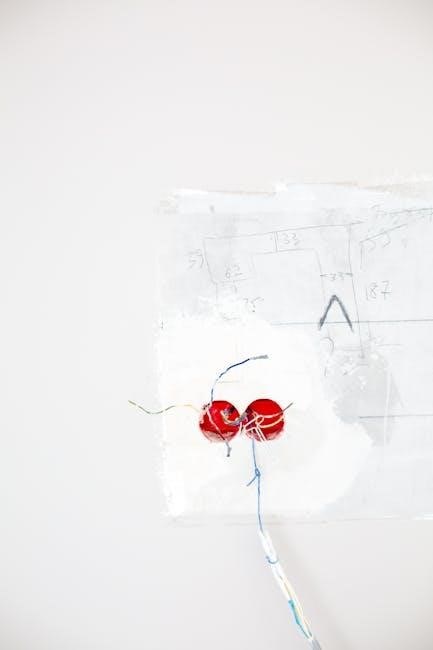A Les Paul wiring diagram is a detailed guide for understanding and modifying your guitar’s electronics. It provides a clear layout of pickups, pots, and switches, ensuring optimal tone and functionality. Whether you’re aiming for vintage 50s-style wiring or modern configurations, these diagrams are essential for any guitarist or luthier. Resources like Mojotone and ToneShapers offer comprehensive PDF guides, making it easier to achieve your desired sound. Start your journey with a standard configuration or explore custom options for unique tonal possibilities.
1.1 Importance of Wiring Diagrams for Les Paul Guitars
Wiring diagrams are crucial for understanding and modifying Les Paul electronics. They provide a visual representation of the guitar’s circuitry, including pickups, potentiometers, tone capacitors, and switches. These diagrams help ensure proper connections, optimal tone, and functionality. Whether you’re restoring a vintage model or upgrading to modern configurations, a wiring diagram is indispensable. It guides technicians and DIY enthusiasts in achieving desired sounds and troubleshooting issues; Resources like Mojotone and ToneShapers offer reliable PDF guides, making it easier to work on your Les Paul with confidence and precision.
1.2 Brief History of Les Paul Wiring Evolution
The Les Paul wiring has evolved significantly since its debut in the 1950s. Early models featured simple circuits with humbuckers, volume, and tone pots, and a toggle switch. Over the years, modifications emerged, such as coil-splitting and active electronics, expanding tonal options. The 50s-style wiring remains popular for its classic tone, while modern configurations offer versatility. Diagrams from Gibson and third-party sources document these changes, providing a roadmap for players to achieve their desired sound. This evolution ensures the Les Paul remains a timeless instrument for musicians across genres.

Understanding the Les Paul Wiring Diagram PDF
The Les Paul Wiring Diagram PDF is a visual guide detailing the electronic connections for pickups, pots, and switches. It includes color-coded wires, solder joints, and layout, ensuring accurate installation or modification. This resource is essential for guitarists and luthiers to achieve proper functionality and desired tones; Key elements like humbuckers, volume pots, and toggle switches are clearly represented, making it a vital reference for both vintage and modern configurations.
2.1 Key Components of the Diagram
The Les Paul wiring diagram PDF highlights essential components like humbucker pickups, volume and tone pots (500K), a 3-way toggle switch, and an output jack. It details wiring types, such as braided or solid core, and solder joints. The diagram also specifies capacitors, like the Orange Drop, and their connections. These elements are arranged to maintain the guitar’s classic tone while allowing for custom modifications. The clear layout ensures accurate installation, making it a vital resource for both vintage and modern setups, as seen in resources like Mojotone and ToneShapers guides.
2.2 How to Read and Interpret the Wiring Diagram
Reading a Les Paul wiring diagram involves identifying components and their connections. Symbols represent pickups, pots, and switches, while lines indicate wiring paths. Color codes differentiate wires, and solder points are marked clearly. Start by tracing connections from pickups to the toggle switch, then to volume and tone pots, and finally to the output jack. The diagram’s legend explains symbols, ensuring clarity. By following the layout, you can accurately wire your guitar for either vintage or modern tones, referencing guides from Mojotone or ToneShapers for additional clarity;

Standard Les Paul Wiring Configurations
Standard Les Paul wiring configurations include 50s-style and modern setups, each designed for unique tonal characteristics. These configurations ensure optimal performance and versatility for players seeking classic or contemporary sounds.
3.1 50s-Style Les Paul Wiring
The 50s-style Les Paul wiring is a classic configuration that delivers a warm, vintage tone. It features two humbucker pickups with independent volume and tone controls, using 500K pots and orange drop capacitors. The toggle switch selects between pickups, providing a straightforward yet versatile setup. This wiring is modeled after the iconic 1950s Les Pauls, emphasizing clarity and sustain. Many modern kits and diagrams replicate this setup, making it a popular choice for those seeking authentic, timeless tones. Its simplicity ensures reliability and ease of use for players and technicians alike.
3.2 Modern Les Paul Wiring Configurations
Modern Les Paul wiring configurations offer enhanced versatility and tonal options. They often include coil-splitting, phase switching, or active electronics for expanded soundscapes. These setups may use no-load tone pots, push-pull pots, or active circuits for added flexibility. Modern wiring diagrams frequently incorporate upgraded components, such as higher-quality capacitors, to refine the tone. Players can achieve a wide range of sounds, from vintage warmth to modern aggression. Many modern configurations are available in PDF guides, allowing for easy implementation and customization to suit individual preferences and playing styles.

Components Involved in Les Paul Wiring
Key components include humbuckers or single-coil pickups, 500K potentiometers for volume and tone, tone capacitors, a 3-way toggle switch, and an output jack. These elements work together to deliver optimal sound quality and versatility, as detailed in Les Paul wiring diagrams.
4.1 Pickups (Humbuckers and Single-Coils)
Pickups are the heart of your Les Paul’s tone. Humbuckers, designed to reduce hum, offer a fuller, richer sound, while single-coils provide a brighter, more articulate response. Both types are featured in Les Paul wiring diagrams, with humbuckers commonly used in modern configurations and single-coils preferred for vintage setups. Proper installation and wiring of these pickups ensure clarity and definition, allowing players to achieve their desired tonal preferences. Understanding pickup wiring is crucial for maintaining or modifying your guitar’s sound.
4.2 Potentiometers (Volume and Tone)
Potentiometers, or “pots,” are essential for controlling volume and tone in a Les Paul. Volume pots adjust the overall signal strength, while tone pots fine-tune frequency response. Typically, 500K pots are used for humbuckers, offering a balanced tone. The logarithmic taper of volume pots ensures smooth signal reduction, while tone pots often use a linear taper for precise adjustments. Proper wiring of these components is critical for maintaining clarity and responsiveness in your guitar’s electronics, ensuring optimal performance and tonal versatility for any playing style.
4.3 Tone Capacitors
Tone capacitors are crucial components in the Les Paul’s tone circuit, influencing the guitar’s high-frequency response; Typically rated at 0.047 microfarads, these capacitors work alongside the tone potentiometer to filter high frequencies. They are usually made of ceramic or film materials, with orange drop capacitors being a popular choice for their clear, articulate tone. Proper installation and wiring of tone capacitors ensure a smooth roll-off of treble when the tone pot is reduced, preserving clarity and articulation in the lower settings. They are essential for achieving the desired tonal balance in your Les Paul.
4.4 Toggle Switch and Output Jack
The toggle switch in a Les Paul is a 3-way selector that allows switching between the neck, bridge, or both pickups. It is typically wired with braided guitar wire for better shielding and noise reduction. The output jack connects the guitar to amplifiers or effects pedals, ensuring a clean signal transfer. Proper installation of both components is crucial for reliable operation and tone consistency. Grounding these parts correctly prevents hum and interference, maintaining the guitar’s overall electrical integrity and performance. These elements are fundamental to the guitar’s functionality and tone delivery.

Tools and Materials Needed for Wiring
Essential tools for Les Paul wiring include a soldering iron and wire cutters. High-quality materials ensure reliable connections, optimal tone, durability, and professional results.
5.1 Soldering Iron and Solder
A soldering iron is crucial for securing connections in Les Paul wiring. Use a temperature-controlled iron for precision, and high-quality 60/40 rosin-core solder ensures durable bonds. Proper soldering techniques prevent oxidation and ensure optimal conductivity, maintaining clear tone and reliability. Always clean the iron tip and use flux if needed for smooth joints. Quality solder is key to avoiding signal loss and ensuring long-lasting electronics performance in your guitar.
5.2 Guitar Wire (Braided and Solid Core)
Guitar wire is essential for connecting components in your Les Paul. Braided shielded wire minimizes noise and interference, ideal for grounding and signal paths. Solid core wire is preferred for permanent connections due to its durability. Use 22 AWG or similar gauge for optimal flexibility and conductivity. Proper insulation ensures signal integrity. Always cut cleanly and strip insulation carefully to avoid damage. Quality wiring is crucial for maintaining clear tone and reliable performance in your guitar’s electronics setup. Choose the right wire type based on the specific connection requirements.
5.3 Wire Cutters and Strippers
High-quality wire cutters and strippers are essential for clean, precise connections. Use 6-inch diagonal cutters for cutting guitar wire and 8-inch strippers for removing insulation. Proper stripping technique avoids nicking the wire, which can cause shorts. Choose tools with comfortable grips for accuracy and control. Invest in durable, professional-grade cutters and strippers to ensure long-term reliability. Clean cuts and precise stripping are critical for maintaining signal integrity and preventing electrical issues in your Les Paul wiring setup.

Step-by-Step Wiring Process
Start with preparing the guitar, then connect pickups to the toggle switch. Solder volume and tone pots, ensuring proper grounding. Finally, wire the output jack carefully.
6.1 Preparing the Guitar for Wiring
Before starting, ensure the guitar is fully disassembled, removing the strings and electronics. Clean the body cavity to ensure proper soldering conditions. Inspect and label all components for easy identification. This step ensures a smooth and organized wiring process, minimizing the risk of errors. Proper preparation is key to achieving a professional setup. Use a wiring diagram PDF for reference, ensuring all parts are accounted for and ready for installation. A clean workspace and labeled components will save time and reduce stress during the wiring process.
6.2 Soldering Techniques for Guitar Wiring
Soldering is a critical skill for guitar wiring. Start by ensuring your soldering iron is properly heated and tinned. Use high-quality solder and apply it evenly to connections. For optimal results, solder wires directly to components like pots and pickups. Avoid excess solder, as it can cause short circuits. Use a desoldering pump if needed. Always ground yourself to prevent static damage. Practice soldering on scrap wires first. For a professional finish, use heat shrink tubing on joints. Clean, shiny solder joints ensure reliable connections and excellent tone. Follow the wiring diagram for correct placement and flow.
6.3 Connecting Pickups to the Toggle Switch
Connecting pickups to the toggle switch is a fundamental step in Les Paul wiring. Identify the hot and ground wires from each pickup. Solder the hot wires to the appropriate lugs on the toggle switch, ensuring proper polarity. Ground wires should be connected to the switch’s ground tab or the guitar’s body. Use high-quality solder for reliable connections. Refer to your wiring diagram for correct placement. Double-check connections to avoid short circuits. Once connected, test the switch to ensure smooth transition between pickups. Proper installation ensures optimal tone and functionality. Follow the diagram carefully for accurate results.
6.4 Wiring Volume and Tone Pots
Begin by connecting the hot wires from the toggle switch to the volume pots. Solder the signal wires to the center lug of the volume potentiometer. Next, connect the tone potentiometers. Solder the tone capacitor to the center lug of the tone pot and ground the outer lug. Ensure all ground wires are soldered to the pot’s backside or a common grounding point. Use 500K pots for humbuckers and 250K for single-coils. Double-check connections for accuracy. Proper wiring ensures smooth operation of volume and tone controls, delivering the desired tonal versatility.
6.5 Final Connections to the Output Jack
Connect the output jack by soldering the guitar’s main signal wire to the tip terminal and the ground wire to the sleeve terminal. Ensure the signal path is clear and secure. Double-check all connections for accuracy and test the guitar to confirm proper operation. Properly grounding the jack prevents hum and ensures reliable signal transfer. This final step completes the wiring process, allowing your Les Paul to function seamlessly with optimal tone and performance. Verify that all components are securely soldered before final assembly.

Customizing Your Les Paul Wiring
Customizing your Les Paul wiring unlocks enhanced tonal versatility. Explore coil-splitting for single-coil tones, phase switching for unique sounds, and active electronics for boosted clarity and dynamics.
7;1 Coil-Splitting for Single-Coil Tones
Coil-splitting modifies humbuckers to mimic single-coil tones. This technique involves wiring the pickup to activate only one coil, reducing hum and delivering brighter, snappier sounds. Humbuckers, designed for full coil operation, achieve single-coil tones through this modification. The process typically requires a push-pull pot or a dedicated switch. When activated, it taps one coil, altering the overall tone. This customization is ideal for players seeking versatility between humbucker warmth and single-coil clarity. Detailed diagrams guide the soldering and wiring steps for precise implementation.
7.2 Phase Switching for Expanded Tonal Options
Phase switching allows for tonal expansion by altering the phase of one pickup relative to the other. When activated, it changes the polarity, creating a unique sound. This is achieved using a DPDT switch, which reverses the phase of one coil. The result is a hollow, quack-like tone, often desired for rhythm and lead work. This modification adds versatility to your Les Paul, enabling a wide range of tonal possibilities beyond standard configurations. It’s particularly popular among players seeking distinctive, modern sounds from their guitar.
7.3 Active Electronics Modifications
Active electronics modifications enhance tonal versatility by incorporating preamps or buffers into your Les Paul’s wiring. These components boost signal strength and provide consistent tone across all volumes. Active setups often include EQ controls for precise tonal shaping. While they offer expanded capabilities, they require a power source and more complex wiring. Players seeking modern, high-gain tones benefit from this setup. However, it’s important to research and plan carefully, as active modifications can alter the guitar’s classic character. Resources like Gibson’s diagrams or third-party guides can help navigate this advanced wiring approach.

Troubleshooting Common Wiring Issues
Troubleshooting wiring issues in your Les Paul involves diagnosing problems like grounding faults, short circuits, or faulty connections. Use a multimeter to test conductivity and isolate issues.
8.1 Identifying and Fixing Grounding Problems
Grounding issues can cause unwanted hum or noise in your Les Paul. Start by inspecting the wiring for loose connections or improper soldering. Use a multimeter to test continuity between the bridge, tailpiece, and ground wires. Ensure the ground wire is securely connected to the rear of the tone pot or the toggle switch. If the bridge isn’t grounded, attach the ground wire to the bridge’s metal base. Avoid common mistakes like inadequate shielding or missed ground points, which can lead to persistent noise. Proper grounding ensures silent operation and optimal tone quality.
8.2 Diagnosing and Repairing Short Circuits
A short circuit in your Les Paul’s wiring can cause loss of sound or excessive noise. Use a multimeter to identify unintended electrical paths between wires or components. Common issues include bare wires touching metal parts or faulty soldering. Inspect the wiring harness, paying attention to areas near the pickups, pots, and output jack. Repair by isolating wires with heat shrink tubing or electrical tape. Ensure all connections are secure and free from oxidation. Patience and precision are key to resolving short circuits and restoring proper functionality to your guitar. Always double-check repairs before testing.
8.3 Resolving Volume and Tone Pot Issues
Volume and tone pots can malfunction due to dust, wear, or faulty wiring. Start by cleaning the potentiometers with a contact cleaner to remove debris. If the issue persists, check the wiring connections for looseness or corrosion. Refer to your Les Paul wiring diagram to ensure all terminals are correctly soldered. If a pot is damaged, replace it with a 500K ohm pot for humbuckers or 250K for single-coils. Proper installation and soldering will restore smooth operation and maintain your guitar’s tone integrity. Always test the pots after repairs to ensure functionality.

Safety Precautions When Working with Guitar Wiring
Always use a soldering iron with caution, avoiding burns and electrical shocks. Protect the guitar’s finish with a covering cloth. Ensure proper grounding and unplug the guitar when working.
9.1 Proper Use of Soldering Iron
When using a soldering iron for guitar wiring, always handle it with care to avoid burns. Ensure the iron is set to the correct temperature, typically between 300-400°F, to prevent damage to components. Use a soldering stand to keep the iron stable and away from flammable materials. Never touch the tip with bare hands and keep loose clothing tied back. Allow the iron to heat up fully before soldering and unplug it when not in use to maintain safety and efficiency.
9.2 Avoiding Electrical Shock
When working on your Les Paul’s wiring, always ensure the guitar is unplugged from any power source. If your guitar has active electronics, disconnect the battery to prevent electrical shock. Use insulated tools and work in a dry environment to minimize risks. Avoid touching live circuits or wires with bare hands. Ground yourself by wearing an anti-static strap or touching a grounded metal object. Keep the work area well-lit and avoid rushing, as this can lead to accidental contact with live components. These precautions will help ensure a safe and incident-free wiring experience.
9.3 Protecting the Guitar’s Finish
When working on your Les Paul’s wiring, protect its finish by covering the body with a soft, non-abrasive cloth or pad. Avoid placing tools directly on the guitar’s surface, as they may scratch or dent the finish. Use a neck support or guitar workbench to keep the instrument stable. Prevent chemicals like solder flux or cleaning agents from coming into contact with the finish. Handle the guitar gently and avoid excessive pressure or friction. After completing the wiring, clean any residue or fingerprints with a dry, lint-free cloth to maintain the finish’s integrity.

Resources for Les Paul Wiring Diagram PDF
Find official Gibson diagrams, third-party guides, and community support online. Mojotone and ToneShapers offer detailed PDFs, while forums provide additional wiring tips and troubleshooting advice.
10.1 Official Gibson Wiring Diagrams
Gibson provides authentic wiring diagrams for their iconic Les Paul models. These official resources ensure accuracy and consistency with the original designs. Available on Gibson’s website, the diagrams cover various configurations, including 50s-style and modern setups. They are invaluable for maintaining the classic tone and functionality of your Les Paul. By following these official guides, you can achieve professional results and preserve your guitar’s heritage. These resources are trusted by luthiers and enthusiasts worldwide for their precision and reliability.
10.2 Third-Party Wiring Diagrams and Guides
Beyond Gibson’s official resources, third-party wiring diagrams offer diverse modifications and customizations. Websites like Mojotone and ToneShapers provide detailed PDFs for unique configurations, such as coil-splitting and phase switching. These guides cater to both vintage enthusiasts and modern players seeking expanded tonal options. They often include step-by-step instructions and component recommendations, making complex wiring accessible to DIY enthusiasts. These third-party resources are a valuable asset for those looking to experiment with their Les Paul’s electronics beyond standard setups.
10.3 Online Communities for Wiring Support
Online forums and communities are invaluable for Les Paul wiring support. Websites like TDPRI, Gibson forums, and Reddit’s guitar community offer extensive discussions, diagrams, and troubleshooting tips. Members share real-world experiences, mods, and solutions, making these platforms a goldmine for DIY enthusiasts. Whether you’re stuck on a wiring issue or exploring custom setups, these communities provide expert advice and resources to help you achieve your tonal goals. Active participation ensures you stay updated on the latest wiring trends and techniques.
11.1 Summary of Key Points
This guide provides a detailed exploration of Les Paul wiring diagrams, highlighting their significance for achieving optimal tone and functionality. It covers standard configurations, such as 50s-style and modern wiring, and offers insights into customization options like coil-splitting and active electronics. Additionally, it addresses troubleshooting common issues and emphasizes safety precautions. Resources like Mojotone and ToneShapers wiring diagrams are recommended for further exploration. By understanding these concepts, guitarists can enhance their instrument’s performance and unlock a wide range of tonal possibilities.
11.2 Encouragement for Further Exploration
With this guide, you’ve gained a solid foundation in Les Paul wiring. However, the journey doesn’t end here—encourage yourself to explore beyond standard configurations. Experiment with coil-splitting, phase switching, and active electronics to unlock unique tones. Utilize resources like Mojotone and ToneShapers wiring diagrams for inspiration. Join online communities to share ideas and learn from experienced guitarists. Remember, wiring is an art that evolves with creativity and practice. Embrace the process, and you’ll discover endless possibilities to shape your sound and make your Les Paul truly one-of-a-kind.
